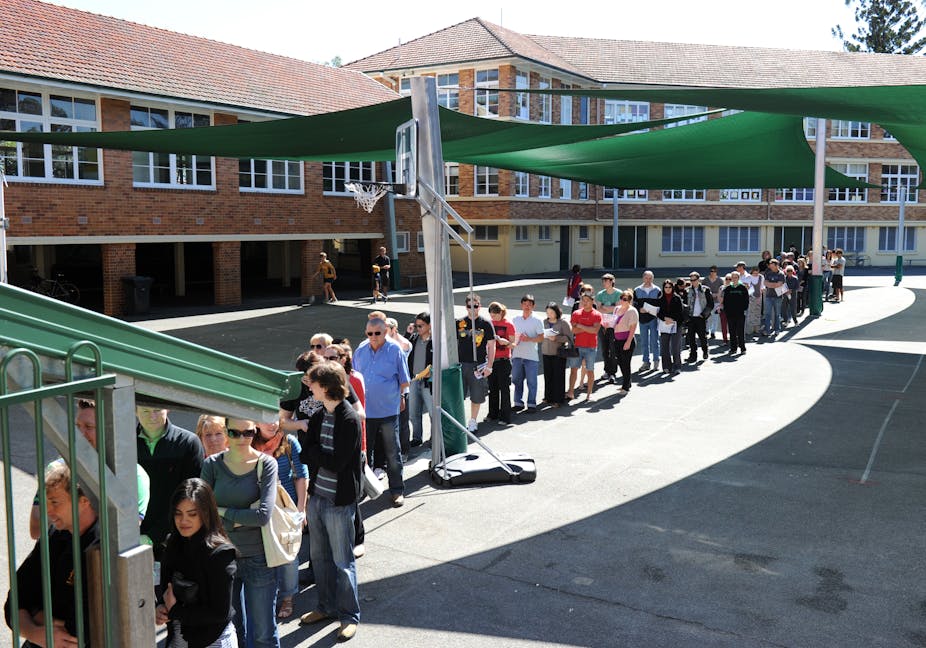Following the prime minister’s surprise announcement of a federal election for September 14, attention will inevitably fall on the role Labor’s key electoral reforms may play in the coming contest. Alongside a plethora of routine updates, the most significant change this government has made has been the long-overdue overhaul of Australia’s electoral enrolment procedures. Also contentious, but far less significant in impact, will be proposed reforms to political donations.
In Australia, electoral enrolment is compulsory. But over the past decade enrolment has declined alarmingly, to the degree that last year upwards of 1.5 million eligible Australians were estimated to be missing from the roll. There are two reasons for this figure – many Australians simply don’t enrol in the first place, and through the limits of legislation and funding the Australian Electoral Commission (AEC) was proving more effective at getting voters off the roll than back onto it.
Last year the Parliament passed legislation establishing a system of direct, computer-assisted enrolment, re-enrolment and roll maintenance. Essentially, this new system allows the AEC to initiate enrolment, using the same trusted information from the likes of Centrelink and road and traffic authorities that was previously used to mail out and process enrolment forms and remove voters from the roll when they moved house.
This echoed similar state-level systems adopted by New South Wales and Victoria, and was to a degree necessitated by them due to, as psephologist Antony Green notes, an emerging divergence between the state and commonwealth electoral rolls. Such systems are not uncommon internationally, and direct enrolment is an important step in keeping Australia’s electoral system up to date.
Nonetheless, the move was met with predictable outrage from the opposition, with senior Coalition frontbencher Christopher Pyne labelling it a Labor rort that would “undermine democracy hideously”, perhaps spurred by analysis suggesting it could cost the Coalition a number of seats.
But is this worry justified? It is assumed that as the problem of enrolment is biggest among the young and the mobile, increasing enrolment will disproportionately benefit Labor and the Greens, due to their greater appeal among these voters.
Yet this is not an argument against reform in itself, nor is it a given. The ALP has not always been the party of the young, nor has the Coalition always been unable to connect with these demographics. Indeed, recent polling across marginal seats, where the election will be won, suggests the Coalition is more popular among voters aged 18-34 than aged 35-55. It is perhaps a safer bet that these reforms will lead, at least initially, to a further drop in turnout and increase in informality, as Direct Enrolment will surely cover many who have not enrolled because they have no interest in electoral participation, or fundamentally oppose compulsion.
Regardless, the hypothetical effects of full enrolment will not be seen at this election. The AEC has been open about its caution in implementing the new system. A progressive rollout only commenced late last year, beginning with a pilot program in Tasmania, and while the new system will be in operation in all states and territories by the time of the election, the AEC estimates that it will take two to three election cycles to enrol even one third of the missing voters.
A second reform, currently before the senate, will lower the threshold above which donations to political parties must be reported to somewhere near $1000. This is a return to the level in operation prior to 2005, when the Howard government increased it to $10,000, plus indexation. The return was first flagged in the Rudd government’s 2008 Electoral Reform Green Paper, and is an important first step towards greater transparency in a system that is currently as clear as mud.
Any impact on the coming election will, however, be minor. Lower thresholds did not discourage donations in the past, and without spending caps the advertising arms race will continue.
Nor can the system be considered transparent in any meaningful way. While more donations may need to be disclosed, we will not hear about them until well after the next parliament is underway. It is only this coming Friday that we will learn about the donations parties received in the 2011-2012 financial year, some of which were made more than 18 months ago.
In the modern era, when donation information can be made available within days, there is no excuse for a finance regime this opaque.
It seems crazy, but it could take until 2015 to find out how electoral reform shaped the poll on September 14 this year.

